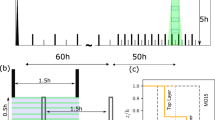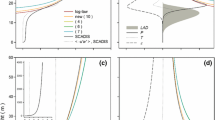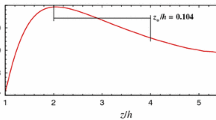Abstract
To investigate how velocity variances and spectra are modified by the simultaneous action of topography and canopy, two flume experiments were carried out on a train of gentle cosine hills differing in surface cover. The first experiment was conducted above a bare surface while the second experiment was conducted within and above a densely arrayed rod canopy. The velocity variances and spectra from these two experiments were compared in the middle, inner, and near-surface layers. In the middle layer, and for the canopy surface, longitudinal and vertical velocity variances (\({\sigma_u^2,\sigma_w^2}\)) were in phase with the hill-induced spatial mean velocity perturbation (Δu) around the so-called background state (taken here as the longitudinal mean at a given height) as predicted by rapid distortion theory (RDT). However, for the bare surface case, \({\sigma_u^2 }\) and \({\sigma_w^2 }\) remained out of phase with Δu by about L/2, where L is the hill half-length. In the canopy layer, wake production was a significant source of turbulent energy for \({\sigma_w^2 }\) , and its action was to re-align velocity variances with Δu in those layers, a mechanism completely absent for the bare surface case. Such a lower ‘boundary condition’ resulted in longitudinal variations of \({\sigma_w^2}\) to be nearly in phase with Δu above the canopy surface. In the inner and middle layers, the spectral distortions by the hill remained significant for the background state of the bare surface case but not for the canopy surface case. In particular, in the inner and middle layers of the bare surface case, the effective exponents derived from the locally measured power spectra diverged from their expected − 5/3 value for inertial subrange scales. These departures spatially correlated with the hill surface. However, for the canopy surface case, the spectral exponents were near − 5/3 above the canopy though the minor differences from − 5/3 were also correlated with the hill surface. Inside the canopy, wake production and energy short-circuiting resulted in significant departures from − 5/3. These departures from − 5/3 also appeared correlated with the hill surface through the wake production contribution and its alignment with Δu. Moreover, scales commensurate with Von Karman street vorticies well described wake production scales inside the canopy, confirming the important role of the mean flow in producing wakes. The spectra inside the canopy on the lee side of the hill, where a negative mean flow delineated a recirculation zone, suggested that the wake production scales there were ‘broader’ when compared to their counterpart outside the recirculation zone. Inside the recirculation zone, there was significantly more energy at higher frequencies when compared to regions outside the recirculation zone.
Similar content being viewed by others
References
Allen T, Brown AR (2002) Large-eddy simulation of turbulent separated flow over rough hills. Boundary Layer Meteorol 102(2): 177–198
Antonia RA, Raupach MR (1993) Spectral scaling in a high Reynolds Number laboratory boundary layer. Boundary-Layer Meteorol 65(3): 289–306
Apsley DD, Castro IP (1997) Flow and dispersion over hills: comparison between numerical predictions and experimental data. J Wind Eng Ind Aerodyn 67(−8): 375–386
Athanassiadou M, Castro IP (2001) Neutral flow over a series of rough hills: a laboratory experiment. Boundary-Layer Meteorol 101(1): 1–30
Ayotte KW (1997) Optimization of upstream profiles in modelled flow over complex terrain. Boundary-Layer Meteorol 83(2): 285–309
Belcher SE, Hunt JCR (1993) Turbulent shear flow over slowly moving waves. J Fluid Mech 251: 109–148
Belcher SE, Hunt JCR (1998) Turbulent flow over hills and waves. Ann Rev Fluid Mech 30: 507–538
Beljaars ACM, Walmsley JL, Taylor PA (1987) Modeling of turbulence over low hills and varying surface-roughness. Boundary-Layer Meteorol 41(1–4): 203–215
Bitsuamlak GT, Stathopoulos T, Bedard C (2004) Numerical evaluation of wind flow over complex terrain: Review. J Aerospace Eng 17(4): 135–145
Bitsuamlak G, Stathopoulos T, Bedard C (2006) Effects of upstream two-dimensional hills on design wind loads: a computational approach. Wind Struct 9(1): 37–58
Bradshaw P (1967) Inactive motion and pressure fluctuations in turbulent boundary layers. J Fluid Mech 30: 241–258
Britter RE, Hunt JCR, Richards KJ (1981) Air-flow over a two-dimensional hill—studies of velocity speed-up, roughness effects and turbulence. Quart J Roy Meteorol Soc 107(451): 91–110
Cava D, Katul GG (2008) Spectral short-circuiting and wake production within the canopy trunk space of an Alpine hardwood forest. Boundary-Layer Meteorol 126: 415–431
Cohen JE, Belcher SE (1999) Turbulent shear flow over fast-moving waves. J Fluid Mech 386: 345–371
Drobinski P, Carlotti P, Redelsperger JL, Banta RM, Masson V, Newsom RK (2007) Numerical and experimental investigation of the neutral atmospheric surface layer. J Atmos Sci 64(1): 137–156
Eidsvik KJ, Utnes T (1997) Flow separation and hydraulic transitions over hills modelled by the Reynolds equations. J Wind Eng Ind Aerodyn 67–8: 403–413
Finnigan J (2000) Turbulence in plant canopies. Ann Rev Fluid Mech 32: 519–571
Finnigan J (2004) The footprint concept in complex terrain. Agric Forest Meteorol 127(3–4): 117–129
Finnigan JJ (1983) A streamline coordinate system for distorted two-dimensional shear flows. J Fluid Mech 130: 241–258
Finnigan JJ, Belcher SE (2004) Flow over a hill covered with a plant canopy. Quart J Roy Meteorol Soc 130(596): 1–29
Finnigan JJ, Bradley EF (1983) The turbulent kinetic-energy budget behind a porous barrier—an analysis in streamline coordinates. J Wind Eng Ind Aerodyn 15(1–3): 157–168
Finnigan JJ, Raupach MR, Bradley EF, Aldis GK (1990) A wind-tunnel study of turbulent-flow over a 2-dimensional ridge. Boundary-Layer Meteorol 50(1–4): 277–317
Frank HP (1996) A simple spectral model for the modification of turbulence in flow over gentle hills. Boundary-Layer Meteorol 79(4): 345–373
Hill TA, Jones A, Choularton TW (1987) Modeling sulfate deposition onto hills by washout and turbulence. Quart J Roy Meteorol Soc 113(478): 1217–1236
Hogstrom U, Hunt JCR, Smedman AS (2002) Theory and measurements for turbulence spectra and variances in the atmospheric neutral surface layer. Boundary-Layer Meteorol 103(1): 101–124
Jackson PS, Hunt JCR (1975) Turbulent wind flow over a low hill. Quart J Roy Meteorol Soc 101(430): 929–955
Judd MJ, Raupach MR, Finnigan JJ (1996) A wind tunnel study of turbulent flow around single and multiple windbreaks. 1. Velocity fields. Boundary-Layer Meteorol 80(1–2): 127–165
Kaimal JC, Finnigan JJ (1994) Atmospheric boundary layer flows: their structure and measurements. Oxford University Press, New York
Katul G, Chu CR (1998) A theoretical and experimental investigation of energy-containing scales in the dynamic sublayer of boundary-layer flows. Boundary-Layer Meteorol 86(2): 279–312
Katul GG, Finnigan JJ, Poggi D, Leuning R, Belcher SE (2006) The influence of hilly terrain on canopy-atmosphere carbon dioxide exchange. Boundary-Layer Meteorol 118(1): 189–216
Kim HG, Lee CM, Lim HC, Kyong NH (1997) An experimental and numerical study on the flow over two-dimensional hills. J Wind Eng Ind Aerodyn 66(1): 17–33
Mann J (2000) The spectral velocity tensor in moderately complex terrain. J Wind Eng Ind Aerodyn 88(2–3): 153–169
Mastenbroek C, Makin VK, Garat MH, Giovanangeli JP (1996) Experimental evidence of the rapid distortion of turbulence in the air flow over water waves. J Fluid Mech 318: 273–302
Miller CA, Davenport AG (1998) Guidelines for the calculation of wind speed-ups in complex terrain. J Wind Eng Ind Aerodyn 74(−6): 189–197
Morfiadakis EE, Glinou GL, Koulouvari MJ (1996) The suitability of the von Karman spectrum for the structure of turbulence in a complex terrain wind farm. J Wind Eng Ind Aerodyn 62(2–3): 237–257
Nikora V (1999) Origin of the “ − 1” spectral law in wall-bounded turbulence. Phys Rev Lett 83(4): 734–736
Parker ST, Kinnersley RP (2004) A computational and wind tunnel study of particle dry deposition in complex topography. Atmos Environ 38(23): 3867–3878
Pellegrini CC, Bodstein GCR (2005) A modified logarithmic law for neutrally stratified flow over low-sloped hills. J Appl Meteorol 44(6): 900–916
Poggi D, Katul GG (2006) Two-dimensional scalar spectra in the deeper layers of a dense and uniform model canopy. Boundary-Layer Meteorol 121(2): 267–281
Poggi D, Katul G (2007a) The ejection-sweep cycle over bare and forested gentle hills: a laboratory experiment. Boundary-Layer Meteorol 122(3): 493–515
Poggi D, Katul GG (2007b) An experimental investigation of the mean momentum budget inside dense canopies on narrow gentle hilly terrain. Agric Forest Meteorol 144(1–2): 1–13
Poggi D, Katul GG (2007c) Turbulent flows inside forested hilly terrain: the recirculation region. Quart J Roy Meteorol Soc 133: 1027–1039
Poggi D, Porporato A, Ridolfi L (2003) Analysis of the small-scale structure of turbulence on smooth and rough walls. Phys Fluids 15(1): 35–46
Poggi D, Katul GG, Albertson JD (2004a) Momentum transfer and turbulent kinetic energy budgets within a dense model canopy. Boundary-Layer Meteorol 111(3): 589–614
Poggi D, Katul GG, Albertson JD (2004b) A note on the contribution of dispersive fluxes to momentum transfer within canopies–research note. Boundary-Layer Meteorol 111(3): 615–621
Poggi D, Porporato A, Ridolfi L, Albertson JD, Katul GG (2004c) The effect of vegetation density on canopy sub-layer turbulence. Boundary-Layer Meteorol 111(3): 565–587
Poggi D, Katul GG, Albertson JD, Ridolfi L (2007) An experimental investigation of turbulent flows over a hilly surface. Phys Fluids 19(3): 036601
Poggi D, Katul GG, Cassiani M (2008a) On the anomalous behaviour of the Lagrangian structure function similarity constant inside dense canopies. Atmos Environ 42: 4212–4231
Poggi D, Katul GG, Finnigan J, Belcher SE (2008b) Analytical models for the mean flow inside dense canopies on gentle hilly terrain. Quart J Roy Meteorol Soc 134: 1095–1112
Raupach MR, Finnigan JJ (1995) Scale issues in Boundary-Layer Meteorol—surface-energy balances in heterogeneous terrain. Hydrol Proc 9(5–6): 589–612
Raupach MR, Finnigan JJ (1997) The influence of topography on meteorological variables and surface-atmosphere interactions. J Hydrol 190(3–4): 182–213
Riziotis VA, Voutsinas SG (2000) Fatigue loads on wind turbines of different control strategies operating in complex terrain. J Wind Eng Ind Aerodyn 85(3): 211–240
Ross AN, Arnold S, Vosper SB, Mobbs SD, Dixon N, Robins AG (2004) A comparison of wind-tunnel experiments and numerical simulations of neutral and stratified flow over a hill. Boundary-Layer Meteorol 113(3): 427–459
Rotach MW, Calanca P, Graziani G, Gurtz J, Steyn DG, Vogt R, Andretta M, Christen A, Cieslik S, Connolly R, De Wekker SFJ, Galmarini S, Kadygrov EN, Kadygrov V, Miller E, Neininger B, Rucker M, Van Gorsel E, Weber H, Weiss A, Zappa M (2004) Turbulence structure and exchange processes in an Alpine Valley—the Riviera project. Bull Am Meteorol Soc 85(9): 1367–1385
Stoll R, Porte-Agel F (2006) Dynamic subgrid-scale models for momentum and scalar fluxes in large-eddy simulations of neutrally stratified atmospheric boundary layers over heterogeneous terrain. Water Resour Res 42(1): W01409
van Boxel JH, Arens SM, Van Dijk PM (1999) Aeolian processes across transverse dunes. I: Modelling the air flow. Earth Surf Proc Landforms 24(3): 255–270
Van Gorsel E, Christen A, Feigenwinter C, Parlow E, Vogt R (2003) Daytime turbulence statistics above a steep forested slope. Boundary-Layer Meteorol 109(3): 311–329
Walko RL, Cotton WR, Pielke RA (1992) Large-eddy simulations of the effects of hilly terrain on the convective boundary-layer. Boundary-Layer Meteorol 58(1–2): 133–150
Wan F, Porte-Agel F, Stoll R (2007) Evaluation of dynamic subgrid-scale models in large-eddy simulations of neutral turbulent flow over a two-dimensional sinusoidal hill. Atmos Environ 41(13): 2719–2728
Wilson JD, Finnigan JJ, Raupach MR (1998) A first-order closure for disturbed plant-canopy flows, and its application to winds in a canopy on a ridge. Quart J Roy Meteorol Soc 124(547): 705–732
Ying R, Canuto VM (1996) Turbulence modelling over two-dimensional hills using an algebraic Reynolds stress expression. Boundary-Layer Meteorol 77(1): 69–99
Ying R, Canuto VM (1997) Numerical simulation of flow over two-dimensional hills using a second-order turbulence closure model. Boundary-Layer Meteorol 85(3): 447–474
Zeman O, Jensen NO (1987) Modification of turbulence characteristics in flow over hills. Quart J Roy Meteorol Soc 113(475): 55–80
Author information
Authors and Affiliations
Corresponding author
Rights and permissions
About this article
Cite this article
Poggi, D., Katul, G.G. Turbulent Intensities and Velocity Spectra for Bare and Forested Gentle Hills: Flume Experiments. Boundary-Layer Meteorol 129, 25–46 (2008). https://doi.org/10.1007/s10546-008-9308-8
Received:
Accepted:
Published:
Issue Date:
DOI: https://doi.org/10.1007/s10546-008-9308-8




